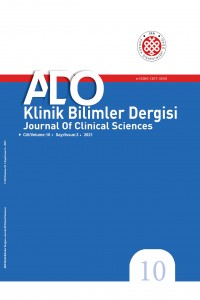Öz
İmplant üstü sabit restorasyonlarda sıklıkla tercih edilen siman tutuculu sistemlerde, artık siman tamamen ortadan kaldırılamadığı için, son yıllarda implant-dayanak tasarımı ve bağlantıları ile ilgili gelişmeler ön plana çıkmıştır. Tüm bu gelişmelere rağmen, artık siman peri-implant hastalıklar için olası bir risk göstergesi olarak tanımlanmaktadır. Peri-implant hastalıklardan korunabilmek ve implantın uzun dönem idamesini sağlayabilmek için, simantasyon sonrası artık simanın tespit edilebilmesi kritik önem taşımaktadır. Bu derlemede, artık simanın tespiti için kullanılan yöntemler klinisyenlere ışık tutması açısından bir araya getirilmiştir.
Anahtar Kelimeler
Artık Siman Tespit Yöntemleri Dental Endoskop İmplant Radyoopsite
Kaynakça
- 1. Lee A, Okayasu K, Wang H-L. Screw-versus cement-retained implant restorations: current concepts. Implant Dent 2010;19:8-15.
- 2. Nissan J, Narobai D, Gross O, Ghelfan O, Chaushu G. Long-term outcome of cemented versus screw-retained implant-supported partial restorations. Int J Oral Maxillofac Implant 2011;26:1102-7.
- 3. Linkevicius T, Puisys A, Vindasiute E, Linkeviciene L, Apse P. Does residual cement around implant‐supported restorations cause peri‐implant disease? A retrospective case analysis. Clin Oral Impl Res 2013;24:1179-84.
- 4. Korsch M, Walther W, Bartols A. Cement‐associated peri‐implant mucositis. A 1‐year follow‐up after excess cement removal on the peri‐implant tissue of dental implants. Clin Implant Dent Relat Res 2017;19:523-9.
- 5. Jepsen S, Berglundh T, Genco R, Aass AM, Demirel K, Derks J, et al. Primary prevention of peri‐implantitis: Managing peri‐implant mucositis. J Clin Periodontol 2015;42:152-7.
- 6. Renvert S, Quirynen M. Risk indicators for peri‐implantitis. A narrative review. Clin Oral Impl Res 2015;26:15-44.
- 7. Wilson Jr TG. The positive relationship between excess cement and peri‐implant disease: a prospective clinical endoscopic study. J Periodontol 2009;80:1388-92.
- 8. Wilson Jr TG. The use of the dental endoscope and videoscope for diagnosis and treatment of peri-implant Diseases. In: Harrel SK, Wilson Jr TG, editors. Minimally Invasive Periodontal Therapy: Clinical Techniques and Visualization Technology. New Jersey: Hoboken; 2015. p.65-75.
- 9. Pope J, Harrel S. Advanced therapeutics for peri-implant problems. Clin Dent Rev 2020;4:1-10.
- 10. Wadhwani C, Rapoport D, La Rosa S, Hess T, Kretschmar S. Radiographic detection and characteristic patterns of residual excess cement associated with cement-retained implant restorations: a clinical report. J Prosthet Dent 2012;107:151-7.
- 11. Alikhasi M, Zadeh BY, Mansourian A, Nokhbatolfoghahaei H. Detection of residual excess zinc oxide–based cement with laser fluorescence (DIAGNOdent): in vitro evaluation. J Oral Implantol 2019;45:89-93.
- 12. Piñeyro A, Ganeles J. Custom abutments alone may not suffice in overcoming negative clinical effects of poor cementation technique. Compend Contin Educ Dent 2014;35:678-86.
- 13. De Martinis Terra E, Berardini M, Trisi P. Nonsurgical management of peri-implant bone loss induced by residual cement: retrospective analysis of six cases. Int J Periodontics Restorative Dent 2019;39:89-94.
- 14. Dukic W. Radiopacity of composite luting cements using a digital technique. J Prosthodont 2019;28:450-9.
- 15. Dukić W, Delija B, Lešić S, Dubravica I, Derossi D. Radiopacity of flowable composite by a digital technique. Oper Dent 2013;38:299-308.
- 16. Wadhwani C, Hess T, Faber T, Piñeyro A, Chen CS. A descriptive study of the radiographic density of implant restorative cements. J Prosthet Dent 2010;103:295-302.
- 17. Vindasiute E, Puisys A, Maslova N, Linkeviciene L, Peciuliene V, Linkevicius T. Clinical factors influencing removal of the cement excess in implant‐supported restorations. Clin Implant Dent Relat Res 2015;17:771-8.
- 18. Reis JMSN, Jorge ÉG, Ribeiro JGR, Pinelli LAP, Abi-Rached FO, Tanomaru-Filho M. Radiopacity evaluation of contemporary luting cements by digitization of images. ISRN Dent 2012;2012:1-5.
- 19. Stuart C, Pharoah M. Oral Radiology: Principles and Interpretation. 6th ed. St. Louis: Elsevier Mosby; 2009.
- 20. Guerreiro-Tanomaru JM, Trindade-Junior A, Cesar Costa B, da Silva GF, Drullis Cifali L, Basso Bernardi MI, et al. Effect of zirconium oxide and zinc oxide nanoparticles on physicochemical properties and antibiofilm activity of a calcium silicate-based material. Scientific World Journal 2014;2014:1-6.
- 21. Pette GA, Ganeles J, Norkin FJ. Radiographic appearance of commonly used cements in implant dentistry. Int J Periodontics Restorative Dent 2013;33:61-8. 22. Piñeyro A, Tucker LM. One abutment-one time: the negative effect of uncontrolled abutment margin depths and excess cement—a case report. Compend Contin Educ Dent. 2013; 34:680-4.
- 23. Graetz C, Schorr S, Christofzik D, Dörfer CE, Sälzer S. How to train periodontal endoscopy? Results of a pilot study removing simulated hard deposits in vitro. Clin Oral Investig 2020;24:607-17.
- 24. Kwan JY, Newkirk SM. Ultrasonic endoscopic periodontal debridement. In: Harrel SK, Wilson Jr TG, editors. Minimally Invasive Periodontal Therapy: Clinical Techniques and Visualization Technology. New Jersey: Hoboken; 2015. p.13-53.
- 25. Kuang Y, Hu B, Chen J, Feng G, Song J. Effects of periodontal endoscopy on the treatment of periodontitis: a systematic review and meta-analysis. J Am Dent Assoc 2017;148:750-9.
- 26. Nouhzadeh Malekshah S, Fekrazad R, Bargrizan M, Kalhori KA. Evaluation of laser fluorescence in combination with photosensitizers for detection of demineralized lesions. Photodiagnosis Photodyn Ther 2019;26:300-5.
- 27. Tassoker M, Ozcan S, Karabekiroglu S. Occlusal caries detection and diagnosis using visual ICDAS criteria, laser fluorescence measurements, and near-infrared light transillumination images. Med Princ Pract 2020;29:25-31.
- 28. Gapski R, Neugeboren N, Pomeranz AZ, Reissner MW. Endosseous implant failure influenced by crown cementation: a clinical case report. Int J Oral Maxillofac Implants 2008; 23:943-6.
- 29. Greenstein G, Tarnow D. Using papillae-sparing incisions in the esthetic zone to restore form and function. Compend Contin Educ Dent 2014;35:315-22.
- 30. Harrel SK, Wilson Jr TG, Rivera‐Hidalgo F. A videoscope for use in minimally invasive periodontal surgery. J Clin Periodontol 2013;40:868-74.
- 31. Harrel SK, Nunn ME, Abraham CM, Rivera‐Hidalgo F, Shulman JD, Tunnell JC. Videoscope assisted minimally invasive surgery (VMIS): 36‐month results. J Periodontol 2017;88:528-35.
- 32. Wilson Jr TG. A new minimally invasive approach for treating peri‐implantitis. Clin Adv Periodontics 2019;9:59-63.
Ayrıntılar
| Birincil Dil | Türkçe |
|---|---|
| Konular | Diş Hekimliği |
| Bölüm | Derleme |
| Yazarlar | |
| Yayımlanma Tarihi | 20 Eylül 2021 |
| Gönderilme Tarihi | 11 Mart 2021 |
| Yayımlandığı Sayı | Yıl 2021 Cilt: 10 Sayı: 3 |


